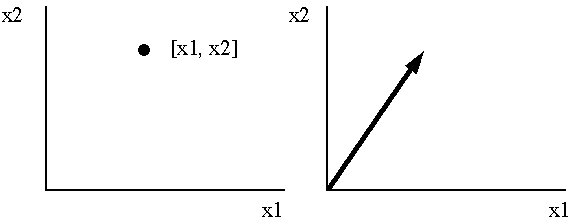
Length of a Vector
Determinant of Covariance Matrix
|Σ| = det(Σ)
Test Vector

Length of a Vector
|x| = sqrt( Σx2)
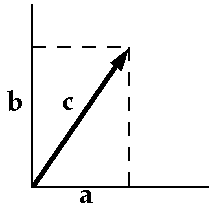
By the Pythagorean Theorem:

Correlation
The correlation between any two vectors is

where θ is the angle between the two vectors.
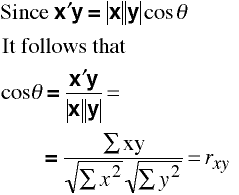
Covariance Matrix
The sample covariance matrix,
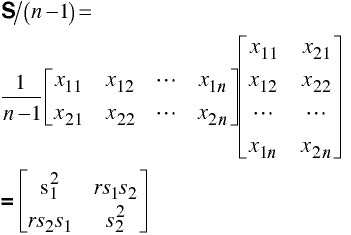
where each xij is the deviation score of the ith person on the jth test.
Determinant
The determinant of the covariance matrix is
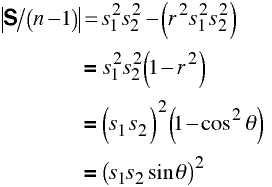

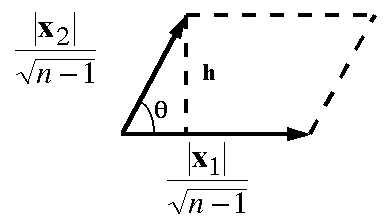
Area = base * height
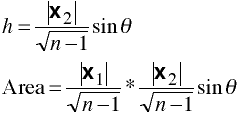
K Groups
Consider k groups with matrices X1, X2, ..., Xk each with p variables.
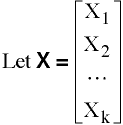
Wilks' Lambda

Where W is the pooled within Deviation SSCP derived separately from each Xi
W = S1 + S2 + ... + Sk
T is the total Deviation SSCP computed from X.
Using covariance matrices:

Univariate Case
When p = 1,
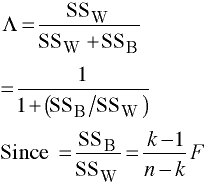
It must be the case that

Thus in the univariate case Λ and F are inversely related. This relation also holds in the multivariate case as well.
F Approximation
An F approximation for Λ is

with df = p(k-1) and ms - p(k-1)/2 + 1, where
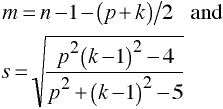
Special Note Concerning s
If either the numerator or the deminator of s = 0, then set s = 1.
Exact F
Three Group Example
Employees in three job categories (c1 Passenger Agents; c2 Mechanics; c3 Operations Control) of an airline company were administered an activity preference questionnaire consisting of three bipolar scales: y1 outdoor-indoor preferences; y2 convivial-solitary preferences; y3 conservative-liberal preferences.
Given matrices W and T, test the hypothesis that the three group centroids are significantly diffenent from one another.
Stata Matrix Program
scalar k = 3
scalar n1 = 85
scalar n2 = 93
scalar n3 = 66
matrix w = (3967.8301, 351.6142, 76.6342 \ ///
351.6142, 4406.2517, 235.4365 \ ///
76.6342, 235.4365, 2683.3164)
matrix t = (5540.5742, -421.4364, 350.2556 \ ///
-421.4364, 7295.571, -1170.559 \ ///
350.2556, -1170.559, 3374.9232)
scalar p = rowsof(w)
scalar dw = det(w)
scalar dt = det(t)
scalar lambda = dw/dt
display "lambda = " lambda
scalar n = n1+n2+n3
scalar c = (n-p-2)/p
scalar f = (1-sqrt(lambda))/sqrt(lambda)*c
display "F = " f
scalar df1 = 2*p
scalar df2 = 2*(n-p-2)
display "df1 = " df1 " df2 = " df2
Stata ExampleExample with significant multivariate but no significant univariates.
Plot of Means
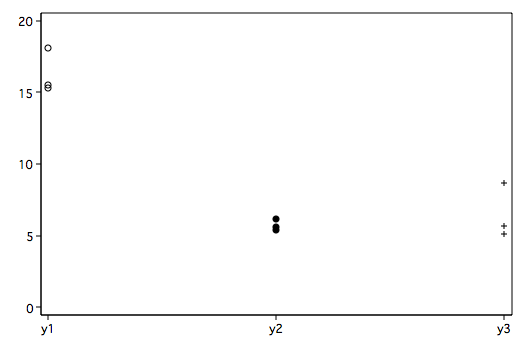
input group y1 y2 y3
1 19.6 5.15 9.5
1 15.4 5.75 9.1
1 22.3 4.35 3.3
1 24.3 7.55 5.0
1 22.5 8.50 6.0
1 20.5 10.25 5.0
1 14.1 5.95 18.8
1 13.0 6.30 16.5
1 14.1 5.45 8.9
1 16.7 3.75 6.0
1 16.8 5.10 7.4
2 17.1 9.00 7.5
2 15.7 5.30 8.5
2 14.9 9.85 6.0
2 19.7 3.60 2.9
2 17.2 4.05 0.2
2 16.0 4.40 2.6
2 12.8 7.15 7.0
2 13.6 7.25 3.2
2 14.2 5.30 6.2
2 13.1 3.10 5.5
2 16.5 2.40 6.6
3 16.0 4.55 2.9
3 12.5 2.65 0.7
3 18.5 6.50 5.3
3 19.2 4.85 8.3
3 12.0 8.75 9.0
3 13.0 5.20 10.3
3 11.9 4.75 8.5
3 12.0 5.85 9.5
3 19.8 2.85 2.3
3 16.5 6.55 3.3
3 17.4 6.60 1.9
end
tabstat y1 y2 y3, by(group) stat(n mean sd var) col(stat)
Summary for variables: y1 y2 y3
by categories of: group
group | N mean sd variance
---------+----------------------------------------
1 | 11 18.11818 3.903797 15.23963
| 11 6.190909 1.899713 3.608909
| 11 8.681818 4.863089 23.64963
---------+----------------------------------------
2 | 11 15.52727 2.075616 4.308182
| 11 5.581818 2.434263 5.925637
| 11 5.109091 2.531187 6.406909
---------+----------------------------------------
3 | 11 15.34545 3.138268 9.848727
| 11 5.372727 1.759029 3.094182
| 11 5.636364 3.546907 12.58055
---------+----------------------------------------
Total | 33 16.3303 3.292461 10.8403
| 33 5.715152 2.017598 4.070701
| 33 6.475758 3.985131 15.88127
--------------------------------------------------
manova y1 y2 y3 = group
Number of obs = 33
W = Wilks' lambda L = Lawley-Hotelling trace
P = Pillai's trace R = Roy's largest root
Source | Statistic df F(df1, df2) = F Prob>F
-----------+--------------------------------------------------
group | W 0.5258 2 6.0 56.0 3.54 0.0049 e
| P 0.4767 6.0 58.0 3.02 0.0122 a
| L 0.8972 6.0 54.0 4.04 0.0021 a
| R 0.8920 3.0 29.0 8.62 0.0003 u
|--------------------------------------------------
Residual | 30
-----------+--------------------------------------------------
Total | 32
--------------------------------------------------------------
e = exact, a = approximate, u = upper bound on FUnivariate Analyses for Comparisons
anova y1 group
Number of obs = 33 R-squared = 0.1526
Root MSE = 3.13031 Adj R-squared = 0.0961
Source | Partial SS df MS F Prob > F
-----------+----------------------------------------------------
Model | 52.9242378 2 26.4621189 2.70 0.0835
|
group | 52.9242378 2 26.4621189 2.70 0.0835
|
Residual | 293.965442 30 9.79884808
-----------+----------------------------------------------------
Total | 346.88968 32 10.8403025
anova y2 group
Number of obs = 33 R-squared = 0.0305
Root MSE = 2.05173 Adj R-squared = -0.0341
Source | Partial SS df MS F Prob > F
-----------+----------------------------------------------------
Model | 3.97515121 2 1.9875756 0.47 0.6282
|
group | 3.97515121 2 1.9875756 0.47 0.6282
|
Residual | 126.287277 30 4.20957589
-----------+----------------------------------------------------
Total | 130.262428 32 4.07070087
anova y3 group
Number of obs = 33 R-squared = 0.1610
Root MSE = 3.76993 Adj R-squared = 0.1051
Source | Partial SS df MS F Prob > F
-----------+----------------------------------------------------
Model | 81.8296936 2 40.9148468 2.88 0.0718
|
group | 81.8296936 2 40.9148468 2.88 0.0718
|
Residual | 426.370896 30 14.2123632
-----------+----------------------------------------------------
Total | 508.20059 32 15.8812684 Multivariate Post-hoc Comparisons
manovatest, showorder
Order of columns in the design matrix
1: _cons
2: (group==1)
3: (group==2)
4: (group==3)
mat d1 = (0,1,-1,0)
mat d2 = (0,1,0,-1)
mat d3 = (0,0,1,-1)
manovatest, test(d1)
Test constraint
(1) group[1] - group[2] = 0
W = Wilks' lambda L = Lawley-Hotelling trace
P = Pillai's trace R = Roy's largest root
Source | Statistic df F(df1, df2) = F Prob>F
-----------+--------------------------------------------------
manovatest | W 0.5875 1 3.0 28.0 6.55 0.0017 e
| P 0.4125 3.0 28.0 6.55 0.0017 e
| L 0.7020 3.0 28.0 6.55 0.0017 e
| R 0.7020 3.0 28.0 6.55 0.0017 e
|--------------------------------------------------
Residual | 30
--------------------------------------------------------------
e = exact, a = approximate, u = upper bound on F
manovatest, test(d2)
Test constraint
(1) group[1] - group[3] = 0
W = Wilks' lambda L = Lawley-Hotelling trace
P = Pillai's trace R = Roy's largest root
Source | Statistic df F(df1, df2) = F Prob>F
-----------+--------------------------------------------------
manovatest | W 0.6109 1 3.0 28.0 5.95 0.0029 e
| P 0.3891 3.0 28.0 5.95 0.0029 e
| L 0.6370 3.0 28.0 5.95 0.0029 e
| R 0.6370 3.0 28.0 5.95 0.0029 e
|--------------------------------------------------
Residual | 30
--------------------------------------------------------------
e = exact, a = approximate, u = upper bound on F
manovatest, test(d3)
Test constraint
(1) group[2] - group[3] = 0
W = Wilks' lambda L = Lawley-Hotelling trace
P = Pillai's trace R = Roy's largest root
Source | Statistic df F(df1, df2) = F Prob>F
-----------+--------------------------------------------------
manovatest | W 0.9932 1 3.0 28.0 0.06 0.9785 e
| P 0.0068 3.0 28.0 0.06 0.9785 e
| L 0.0068 3.0 28.0 0.06 0.9785 e
| R 0.0068 3.0 28.0 0.06 0.9785 e
|--------------------------------------------------
Residual | 30
--------------------------------------------------------------
e = exact, a = approximate, u = upper bound on F
To control for the conceptual error rate, you can divide the p-values by the number
of comparisons for a Bonferroni adjustment.Multivariate Strength of Association
Given a sufficiently large sample almost any difference can be statistically significant.
In the univariate case the correlation ratio measures strength of association,


is a direct multivariate generalization of the correlation ratio. Unfortunately, it tends to be positively biased, grossly overestimating the strength of association.
A better estimate of strength of association is

which is also positively biased, leading to a corrected version.

which is nearly unbiased.
In the example above:
Simultaneous Confidence Intervals
simulci y1 y2 y3, by(group) cv(.325) /* findit simulci */
s=2 m=0 n=13 cv= .325
group variable: group
pairwise simultaneous
comparison difference confidence intervals
dv: y1
group 1 vs group 2 2.591* 0.212 4.970
group 1 vs group 3 2.773* 0.393 5.152
group 2 vs group 3 0.182 -2.198 2.561
dv: y2
group 1 vs group 2 0.609 -0.950 2.169
group 1 vs group 3 0.818 -0.741 2.378
group 2 vs group 3 0.209 -1.350 1.769
dv: y3
group 1 vs group 2 3.573* 0.707 6.438
group 1 vs group 3 3.045* 0.180 5.911
group 2 vs group 3 -0.527 -3.393 2.338
Where cv is the critical value taken from the Heck charts (see Morrison, 2005 or
charts).
Where,Why can't I just do a bunch of univariate anovas instead of a manova?
The answer is you can. Its not the correct analysis but you could do it. There are a couple of problems with running a separate univariate anovas. One is the the analyses are not independent of one another because the response variables are, most likely, correlated with one another. Therefore, an analysis with one response variable is not independent with one done a different one, that is, the analyses do not necessarily provide different or unique information.
Manova uses information from each of the response variables taking into account their correlated nature. This is one reason why multivariate tests are more powerful than their univariate counterparts, they have more information to work with.
But, even if the response variables were completely independent of one another, a multivariate test would be preferred because problems with the conceptual error rate. When response variables are independent and each anova is tested at α, the the probability of making at least one Type I error in n anovas is 1 - (1 - α)n.
The table below gives the probability of making at least one type I error for four different numbers of anovas:
n probability 3 .1426 5 .2262 10 .4013 15 .5367 Conceptual Error RatesAnd once you factor in any post-hoc comparisons in each anova, you have to watch out for problems with the conceptual error rate, in particular the probability that at least one test is significant by chance alone.
Multivariate Course Page
Phil Ender, 23oct07, 17jul07, 25oct05, 20may02, 29jan98